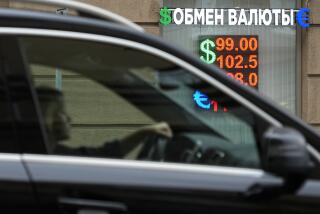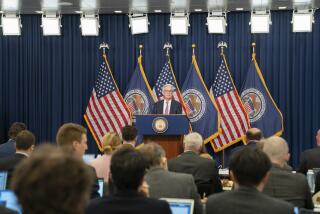Fed’s Renewed Buying Spree Fails to Halt Decline of the Dollar
- Share via
WASHINGTON — The Federal Reserve sought to stem the sinking dollar Wednesday for the second time in three days, this time joined by central banks of three other nations. But the greenback closed lower against most major currencies.
The dollar’s weak position is attributed to factors that cannot be easily or quickly reversed. The Fed and its allies in Europe and Japan are said by international monetary experts to be able to do little more than fine-tune the market. Thus, the operation Wednesday--a sudden foray by the central banks of the United States, Germany, France and Japan to sell Japanese yen and German marks--was expected to have little more than passing impact.
As the trading day neared an end in New York, the dollar was being quoted at 86.04 yen, down slightly from 86.21 the previous day but moving up slightly after having slipped through the 86 level earlier in the day. It had set yet another postwar low of 85.55 yen on Tuesday. It was also being quoted at 1.3725 marks, off from 1.3785 on Tuesday.
The behind-the-scenes moves Wednesday followed a large and public buying spree Monday by the United States and Japan.
Later, Treasury Secretary Robert E. Rubin, backing up the operation with a brief statement signaling coordination among the major trading partners, said the move reflected their belief that “a strong dollar is in the interest of the United States and the more general interest of the economies of the world.”
“We all share the view that intervention has a role to play when used at an appropriate time,” he said.
With as much as $1 trillion changing hands in these global markets daily, the infusion of $1 billion or so can have little impact. But it sends a signal that the central banks, in this case led by Washington, are willing to spend foreign currencies without advance notice to keep the U.S. currency from dropping too low.
While the amount of dollars purchased by the central banks when they intervene is never announced, it is estimated by traders that the intervention Monday involved somewhere between $1 billion and $2 billion, and on Wednesday about $1 billion.
Currency traders suspect that the most recent interventions were intended to help avoid wild gyrations in currency values and to keep the markets guessing about just how low the banks will let the dollar fall. Traders also said the banks want to prevent excessive speculation.
“You have to look at what their intention is,” said Steve Flanagan, vice president of Credit Agricole in New York. “I believe it is to slow the decline and just keep a friendly reminder in the markets that the dollar is at a level they deem to be excessively low. It’s definitely keeping the market off balance.”
More to Read
Inside the business of entertainment
The Wide Shot brings you news, analysis and insights on everything from streaming wars to production — and what it all means for the future.
You may occasionally receive promotional content from the Los Angeles Times.










